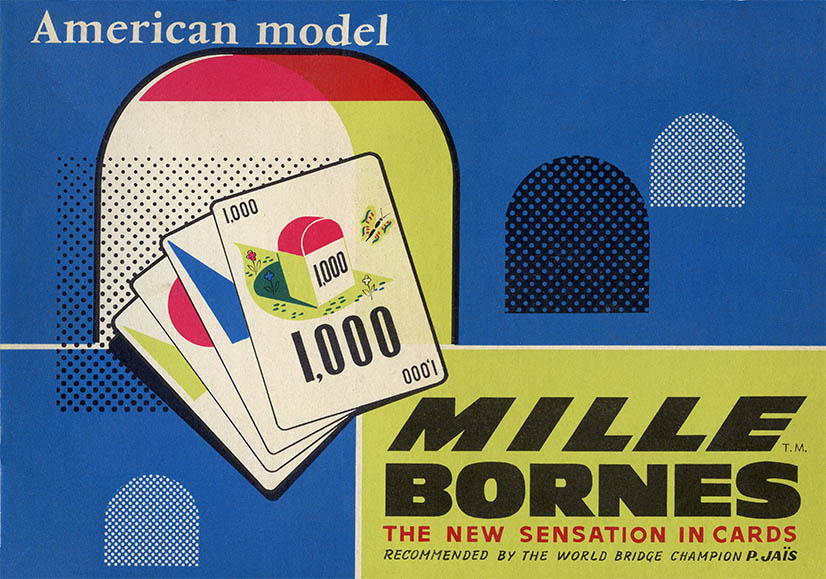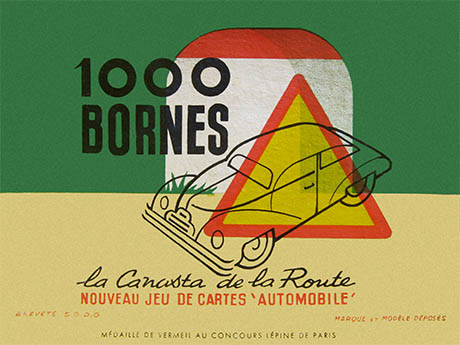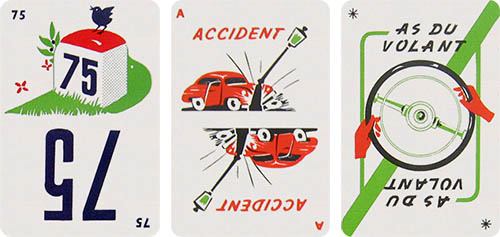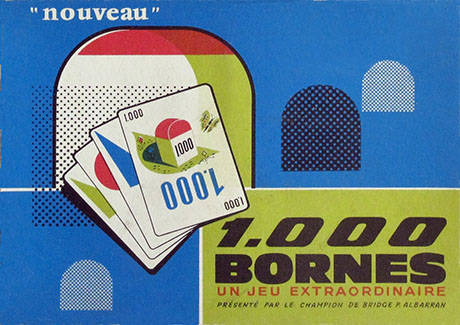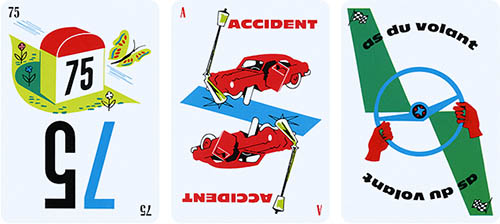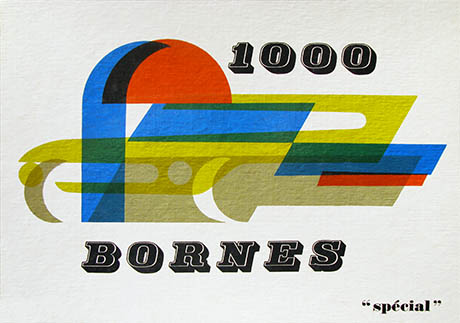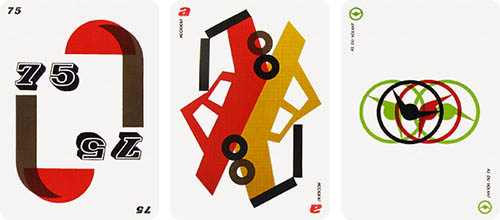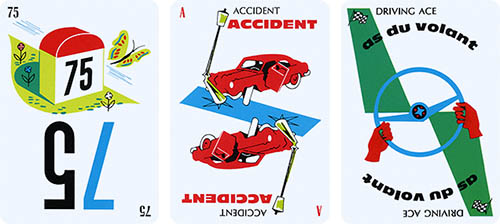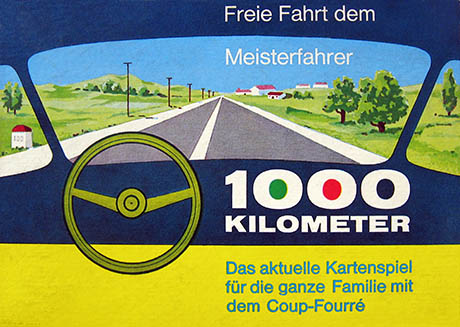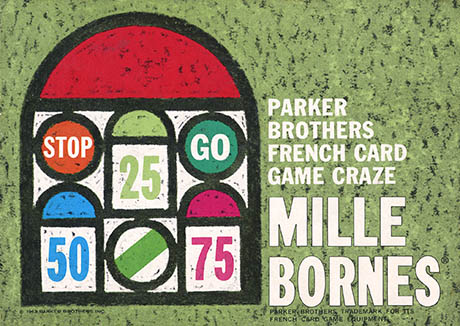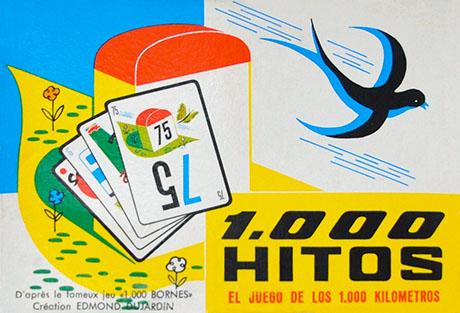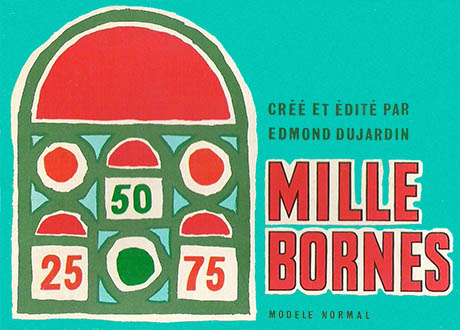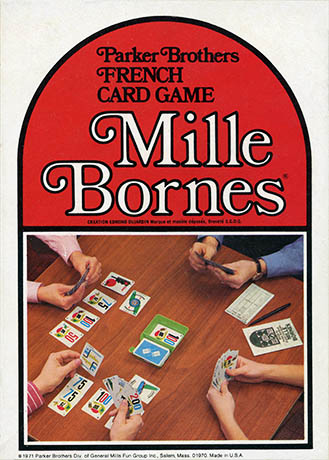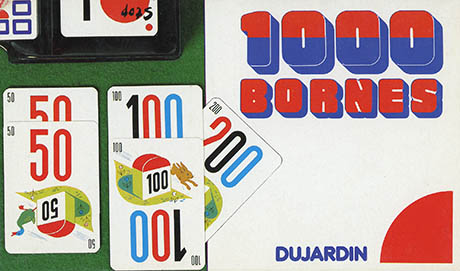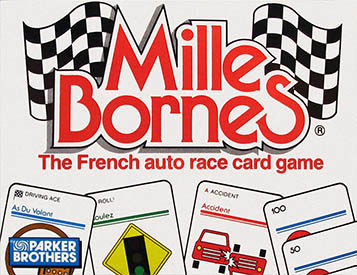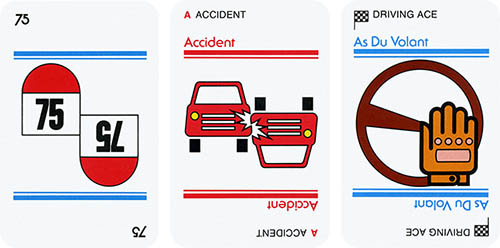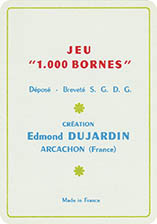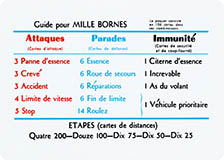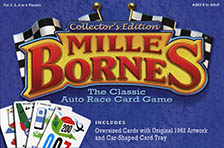28
Mille Bornes
Edmond Dujardin/Joseph Callennec
Arthur (AKA Edmond) Dujardin was born in Ecuador and raised in France where he became the author of, among other things, bilingual dictionaries and driving-school materials. After the war he tried his hand at designing several automotive-themed games, including Coup d’essai, Coup de maître, Carrefour and in 1954, 1000 Bornes.
Dujardin described 1000 Bornes,1 as “la Canasta de la Route,” but the game is not based on canasta but rather on William Janson Roche's 1906 classic Touring, with the addition of safety cards and the novel Coup fourré play.
The game was a popular alternative to Bridge and, as Parker Brothers stated in the US introduction, became “a French Card Game Craze.” To keep up with demand Dujardin moved production from the basement of his family’s home in Arcachon to a renovated fish factory. In all, more than a million copies were sold in France in the 1950s.
The first edition featured a wonderful hand-lettered card design. Shown here is a selection from the original 106 card deck: 2
1000 Bornes, Dujardin, France, 1954
1960 turned out to be an important year for the game. Dujardin released a nouveau edition featuring cards professionally updated by the French graphic designer Joseph Le Callennec.3 His iconic design would become the benchmark that later designs were measured against.
1000 Bornes, Dujardin, France, 1960
That same year Dujardin also released an “edition spécial.” The cards, by an unknown designer, feature an interesting abstract mid-century design. Of the multitudes of Mille Bornes designs over the years these were perhaps the only ones that matched Callenac’s work:
1000 Bornes, Dujardin, France, 1960
Finally in 1960 Dujardin began international distribution of the game – first in England, Italy (Mille Miglia), Germany (1000 Kilometers) and North America (Mille Bornes)4 and eventually pretty much everywhere. These early foreign editions included bi-lingual versions of Callennec’s design:
Mille Bornes, Dujardin, US, 1960
Eventually Dujardin began licensing the game to other companies and the result was (or is) literally hundreds of different editions of the game. Over the last 50+ years it has been estimated that over 10 million copies have been sold worldwide and is one of only 25 games chosen by Games Magazine for their Hall of Fame.
1000 Kilometer, Dujardin, Germany, 1962
Mille Bornes, Parker Brothers, US, 1962
1000 Hitos, Fournier, Spain, 1966
Mille Bornes, Dujardin, France, 1971
Mille Bornes, Parker Brothers, US, 1971
As can be seen from the above examples both Dujardin and it’s licensees periodically redesigned the game – presumably in an attempt to “freshen” it for new audiences. For Dujardin and the French editions these redesigns meant new boxes; aside from a few specially-themed sets they wisely stuck with Callennec’s iconic 1960 cards:
1000 Bornes, Dujardin, France, ca.1990
The foreign licensees, on the other hand, had absolutely no problem redesigning the cards. In general each graphic iteration became progressively more derivative and generic and by the 1980s the cards displayed none of the originality or (and I’ll just go ahead and say it) charm of Callennec’s original design. For example here are the 1982 cards which were produced by Parker Brothers for more than two decades:5
Mille Bornes, Parker Brothers, US, 1982
Like many games of the 1950s/60s, Mille Bornes was originally marketed to adults. The adult game market, however, was essentially gone by the mid-1970s and the teenage market was continually eroded by television, then video games and finally the internet. The result is that the few remaining game publishers now market their games mostly to younger children. This has meant a change from the graphic design of the 1950s to the mostly cartoon illustration of today. Mille Bornes is, sadly, just a typical example.
1. 1000 kilometers was chosen based on the approximate length of the Nationale 7 (RN 7, Paris→ Nemours→ Lyon→ Avignon→ Italy). Oddly, however, each hand in the game is played to 700 kilometers. Go figure.
2. To Dujardin’s credit, the rules and the 106-card deck have remained unchanged. He resisted the temptation to add, e.g., special collectable foil-stamped holographic monster power cards. This guide card, from the 1962 Parker Brothers edition, is still valid:
3. Joseph Le Callennec (1905―1988) was, aside from his Mille Bornes designs, perhaps best known for his logos and design work for Béghin-Say (sugar, or in French, sucrose), Pie qui chante (candy) and Céma (margarine).
4. The game became so popular in the US that for a short period in the early 1960s it was Parker Brothers most popular title – even outselling the venerable Monopoly.
5. Although the the 2003 Winning Moves Collector’s edition, as a specific marketing point, reverted to the “original” 1962 design:
21 May 2009, updated 22 Oct 2012 ‧ Design
